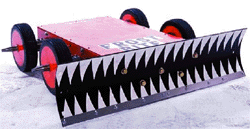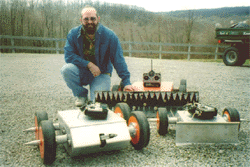 |
53 (5) (2001), pp. 12-14 |
|---|
Feature: Overview
 |
53 (5) (2001), pp. 12-14 |
|---|
|
|
|
|
||
|
|
|
|
||
|
|
|
|
It was on the cover of Fortune magazine that Michael
“Fuzzy” Mauldin received his first national media exposure. That was in
1995, when Mauldin
founded Lycos, one of the
Internet’s first search engines.
In 2001, cameras were focused on Mauldin
again, but this time they were the property of the cable television network
Comedy Central. His
claim to fame: Frostbite,
a fighting robot (Figure 1).
Mauldin, who was
all of 37 when he retired from his career as a research computer scientist in
1996, is filling his time lately with cable television’s newest sport: robot
wars. Within the last year, two networks have launched programs geared toward
technically advanced audience members fondly referred to as geeks: BattleBots
came first on Comedy
Central, followed by Robotica
on The Learning Channel
(TLC).
“This is hero geeks, in a way,” said Greg Munson, a co-creator of BattleBots
and former robot battler. “We all know who Steve Jobs is or Bill Gates, but
we don’t know who was in the trenches, developing the Windows operating system
or the Macintosh operating system. BattleBots
brings out the engineers and makes them into celebrities.”
|
|
 |
|
Figure 1. Frostbite, the heavyweight robot with a snowplow in front, was Michael Mauldin’s first BattleBot. |
 |
|
Figure 2. The “kill-saw” effect on the floor of the Battlebox. |
Evidently, the engineers have been waiting for their chance to
shine. With two million viewers, BattleBots
ranked as one of Comedy
Central’s top-rated series premieres when it was launched in August 2000.
Viewing has remained strong, and the number of participants in the robot battles
has soared. More than 650 teams are registered for battles scheduled for May
compared to about 130 teams in November.
The program, like its counterpart on TLC,
is tapping into a West Coast trend that has been popular for several years.
People, mostly young men, spend hours and thousands of dollars creating remote-controlled
robots, only to place them in a ring for metal vs. metal destruction. Munson
said the hobby is especially popular among the many special-effects technicians
employed in California’s entertainment industry. He and his cousin, Trey Roski,
chief executive officer of BattleBots,
Inc., grew up in California where they developed a fascination with what
Munson termed “mechanical mischief.”
“Some kids would spray paint graffiti; we would painstakingly spend hours making
something out of Legos
and then elaborately blow them up,” Munson said. Eventually, the cousins moved
on to building and battling robots, and then, organizing robot fights. One such
event caught the eye of a sports promotion company, and the first televised
battle was arranged in November 1999 as a pay-per-view cable program.
“It flopped. Nobody watched it,” Munson said. Well, almost nobody. Decision
makers at Comedy Central
watched and offered to broadcast the next event as a television series. For
maximum excitement, Munson and Roski developed an arena called a Battlebox,
enclosed in shatterproof glass and equipped with hazards such as tungsten-tipped
buzz saws and spikes that emerge from the floor (Figure
2). Sports announcers were added, and Bill
Nye, host of the popular public television science program, Bill Nye the
Science Guy, was hired to provide on-air technical expertise.
This time, people watched. People like Fuzzy
Mauldin, who, with a little know how and a lot of time, set out to build
the ‘bot that would beat the competition. He cleared a space in his garage and
began work on Frostbite,
a low, rectangular robot with a snowplow attached. The body and the blade were
made of thick steel. Although weapons that smash and skewer may have some primal
appeal, Mauldin
decided to build a sturdy body for better protection. The blade could work as
a weapon, pushing opponents into hazards on the arena floor.
Robot construction is limited by weight; a Battlebot can be light, middle, heavy,
or super-heavy weight. Frostbite,
a heavyweight that cost about $4,000 to build, won two rounds in November, but
lost in the quarter-finals. The battle-scarred machine has gouges in its blade
from the Battlebox saw blades and tire prints on its back in blackened remembrance
of a run-in with Overkill,
the robot that defeated it. Now, Frostbite
is retired, relegated to plowing snow at Mauldin’s home in the suburbs of Pittsburgh,
Pennsylvania, and helping test the fighting skills of the four new robots under
construction (Figure 3).
|
|
 |
|
Figure 3. Michael Mauldin with Frostbite and newcomers Wind-chill and Ice Cube. |
Cars have no place in the Mauldin garage anymore. They have been
replaced with steel sheets, batteries, motors, tools, and more. The garage is
something of an operating room for robots, with an ample supply of vital organs.
“He’s obsessed . . . he lives, eats, and breathes robots,” said Mauldin’s wife,
Debby. But the two have only been married a year, and she is understanding.
As Mauldin listed
the expenses of building better robots for the May competition (Iceberg,
Frostbite’s
super-heavyweight replacement, will consume $5,000 in batteries alone), Debby
smiled at him and said, “It’s a good thing I love you.”
He has a proficiency for technical matters, but Mauldin
said his education— Ph.D. in computer science from Carnegie
Mellon University—is of little use when it comes to building robots. An
understanding of mechanics and electronics is just as important as physics when
it comes to the sport of robotics, Mauldin said.
The wide spectrum of skills needed to build robots leads to an interesting blend
of enthusiasts, said Gena McCarthy, producer of The
Learning Channel’s Robotica
series, which premiered in April.
“They come from all across the board,” she said of the show’s contestants. “We
have engineers and we have people who work for Mattel, designing toys . . .
several web consultants, and a magician. We wanted to recruit a wide range of
contestants so we could have really interesting pairings, match an MIT
engineer with an amateur,” McCarthy said. “The outcomes are quite surprising.”
Robotica
is a less violent robot competition, with the machines competing on several
levels before trying to push each other off the raised stage. Challenges that
must be overcome before the robots fight include a maze, a race, and an obstacle
course.
“These are our ultimate robots, sort of the thoroughbreds in the field,” said
McCarthy. “They’re created to execute for very different and discreet challenges
so they have to be strong enough, they have to be smart enough, they have to
be fast enough to succeed.”
Although the program was aired on the heels of BattleBots’
success, McCarthy said it reflects TLC’s
interest in “techno competition.” The network already has a successful show
called Junkyard
Wars, in which contestants are challenged to build complex machines
using supplies gathered from a salvage yard. If Robotica
is successful, McCarthy said, expanded techno-competition programming can be
expected.
As BattleBots
has grown more popular, Bill
Nye has seen the robots evolve and improve. “Every time they get more and
more robust,” he said. Some builders are even splurging on titanium, banking
on its toughness to help the robots deliver—and survive—a beating. Nye, who
earned a degree in mechanical engineering from Cornell
University, enjoys watching the progression.
“If I were a young man out of engineering school I would be all over this thing,”
he said. “It’s cool, you build a gizmo to do this one thing. It’s like a warrior
or a soldier.”
The robots have ranged in eye appeal from silver, rectangular boxes to a red
lady-bug sandbox hiding a saw blade under its wings. That robot, which falls
into Nye’s “most creative” category, was designed by a 14-year-old girl.
Nola Garcia, who has been hired by BattleBots
to develop a high school BattleBots
curriculum, looks forward to dramatic design improvements as technical knowledge
expands with each competition.
“There’s only so far football can go, or basketball. With robots, we are in
our infancy,” Garcia said. “We’re going to look back on these times and see
how primitive we were and laugh.”
|
|
|
||||||
|
CREATING A CURRICULUM
FROM “TRASH TV WITH A PURPOSE”
“He had to kick them out of the school,” Garcia said. “Where do you see that happen?” Bastoni has ignited student interest by connecting classroom theories with tangible, and even fun, challenges: race cars and robots. In May, his students will field two robots in a BattleBots competition. In August, the students will be among the first to participate in BattleBots IQ—The High School Challenge, putting their robots, Reactor and Gungir, to the test (Figure A). The prospect of building battling robots has so captured students’ interest they want to come to school— even on their days off. “We pray for snow days so we can be in here alone and not have to go to class,” Bastoni said. “They come in in droves on snow days.” Greg Munson, co-creator of BattleBots, said the high school version will launch a combination curriculum/ competition in which students, accompanied by a qualified instructor, build and battle robots. He plans to televise the competition in a spin-off series for younger audiences. The benefits, he hopes, would be two-fold: BattleBots IQ would inspire other schools to adopt the unusual curriculum, and it would cultivate a market for an upcoming BattleBot toy line. The youth market is a potential BattleBots niche that became apparent soon after the series premiered. “We received e-mail from moms saying their kids would watch WWF (World Wrestling Federation) and they would go out and break furniture over each other in the backyard. They saw our show, got the Legos out, and started building something,” Munson said. Needless to say, the mothers were not complaining.
Garcia has consulted with Bastoni to learn more about his robotics curriculum, which has been in place for six years. In addition, Alexander Slocum, a professor who specializes in robotics at the Massachusetts Institute of Technology, has been advising her. “This is going to bridge math and science with the technical-vocational education, where they’ve been very separate until now,” Garcia said. Garcia is convinced construction of that bridge is long overdue. After a notice of BattleBots IQ was posted on the BattleBots web site, Garcia was inundated with enthusiastic messages from teachers, students, and engineers. As of last month, she was still choosing school districts to test the curriculum, which is planned to be instituted in the fall. Garcia expects the curriculum to be built around a framework that includes honors physics, geometry, and technology classes with instruction on electrical systems and three-dimensional modeling. In Bastoni’s classes, where students have in the past built robots for less combative competition, individual strengths are given a chance to shine in a new approach to technical education. “In the ‘70s, we would take the less motivated, less interested students and put them in the most interesting environments— metal shop, wood shop. . . and we would take these more motivated students and relegate them to a tremendous amount of seat time. I think what we’ve learned in the last decade was maybe we were doing it a little backwards,” Bastoni said. In the robotics class, students with welding skills are putting BattleBots together while the math wizards apply calculus expertise to the robot’s movement. All types of students are needed to complete the project, Bastoni said, and all have something in common: “They’re all hard working and motivated.” Bastoni, who visited BattleBots in November before deciding to commit his students to the competition, saw educational potential in the robot carnage. “You’ve got robots, and they’re fighting, but they’re fighting for a reason, they’re fighting for things like technical literacy, they’re fighting for things like engineering environments in school. If you capture the imagination of young kids anyway, why not do something good with it?" “It’s not trash TV for the heck of it, it’s trash TV with a purpose.” To see the latest activities of Bastoni’s students, visit http://pnta.org/battlebots/robotics.htm |
GETTING ACQUAINTED
WITH THE MAN BEHIND THE SCIENCE GUY
Nye, who provides technical commentary for BattleBots, holds a degree in mechanical engineering (“I’m all over stress and strain”) and a lifelong love for building things. So when Bill Nye talks about the benefits of titanium or the drawbacks of spinning weapons, people listen. “We were real happy to get Bill Nye,” said Greg Munson, co-creator of BattleBots. “We love his show.” Although the PBS program is no longer in production, Nye remains busy with his BattleBots duties and with a new program on the cable network Noggin. Still, he took time out to share some insights on science, robots, and feminism with JOM. Q. From an engineering perspective, what makes for a good BattleBot? A. The big thing for me that’s missing from all of them is what I would call drivability or maneuverability. Q. Is there something that can be done in the building process to make the robots more manageable? A. No, they (builders) need time. They’re making them in their spare time. Q. Have you seen the robots evolve? A. Oh yeah, every time they get more and more robust. Q. Are the materials they’re made out of changing? A. Yes, the last one was made out of titanium. Q. What would be the benefit of titanium? A. They kind of get wailed on. If you have something that can take the punishment you’re way better off. Q. Are there any drawbacks to building with titanium? A. It’s tough, it’s much harder to work. Q. What’s the point of building a robot and watching it get destroyed? A. It’s like a warrior or a soldier. You believe in your heart that yours will not get destroyed. That’s why you do it. Q. What is the most creative design you’ve seen? A. I think the ladybug (a ladybug that opened its wings and encapsulated its opponent, with a saw blade spinning under the wings). The ladybug was very creative. The most creative robots overall were the snakes. (The creator) had a whole bunch of them. He was so creative but his robots have not been that effective in battle. Q. How would you describe the people you’ve seen competing? A. They’re gearheads, they like mechanisms, they like devices, and I think they’re very creative. They’re crafters, tinkerers. Q. Is this a necessary outlet for tinkerers? A. Let’s talk briefly about ME. My nickname is Projectman. I’ve optimized the ergonomics of my world. These people are very much that way. People talk about engineers as nerds and socially inept, but I’ll tell you, there’s hardly anybody more creative than an engineer. We all take it for granted, don’t we? ‘Why can’t they make a decent car? What’s wrong with my computer? Why is this corn so expensive?’ It’s all engineering, my friend. Q. How early did you have this need to tinker? A. Before I can remember. I made lot of paper airplanes. Q. Did it drive your parents crazy? A. Oh no, they were very supportive of science. My mom was recruited out of college to work on the Enigma code (a World War II Nazi code). The Allies broke the code. She was recruited because she was good at math and science. That was a cool time—she was single, she was a woman in uniform, working in Washington D.C., saving the world. But she could not get a credit card. I just want you to not take this for granted, this was 1968, 1970 maybe. Now you gals, everybody can get a credit card without thinking twice about it. Q. Was your father involved in science? A. My father was a salesman, but he was an amateur astronomer. Just about a month ago the Smithsonian accepted a copy of his book, his seminal work, “Sundials of Maryland and Virginia.” Q. Have you ever built a robot? A. No. If my lifestyle were totally different, if I had a day job, I would try it. The robot I look forward to seeing someday is a parasite bot; this would be some sort of robot that would be small and in every way analogous to a germ. It would somehow attach itself to the enemy and bore into it and disable it. Once you get through the outside of the robot, you can ruin it. Q. What have been the outstanding weapons you’ve seen? A. Any of the spinning stuff. When you have a spinning weapon, if you can just get any part of it in contact with the enemy’s hull, you’re going to impart some energy to it, the weapon’s going to deliver some of its punch. Q. Do you enjoy your work as much as you appear to? A. Oh yeah. There’s nothing more fun than making a point on television. |
||||||
|
|
|
Maureen Byko is managing editor of
JOM.
Direct questions about this or any other JOM page to jom@tms.org.
| If you would like to comment on the May
2001 issue of JOM,
simply complete the JOM on-line critique form |
|||||
|---|---|---|---|---|---|
| Search | TMS Document Center | Subscriptions | Other Hypertext Articles | JOM | TMS OnLine |